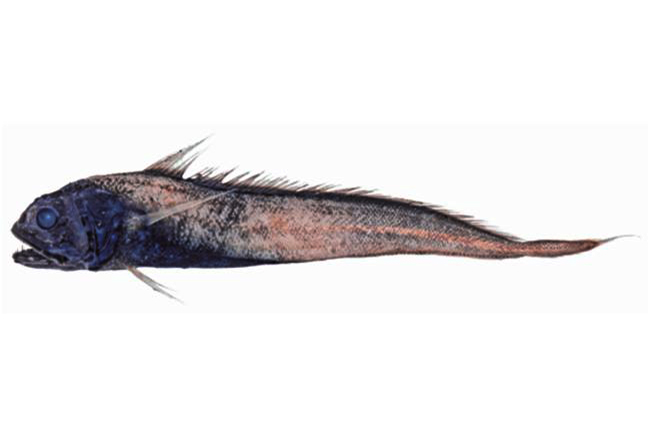Arrowtail Cod, Melanonus zugmayeri Norman 1930
Other Names: Arrowtail

Arrowtail Cod, Melanonus zugmayeri. Source: Ken Graham / NSW Fisheries. License: All rights reserved
Cite this page as:
Bray, D.J. 2020, Melanonus zugmayeri in Fishes of Australia, accessed 27 Jun 2025, https://fishesofaustralia.net.au/home/species/4570
Arrowtail Cod, Melanonus zugmayeri Norman 1930
More Info
|
Distribution |
Northwest Shelf, west of the Montebello Islands, to south of Scott Reef, Western Australia, and east of Wallis Lake, New South Wales, to the Great Australian Bight, South Australia, and off Tasmania (south to the South Tasman Rise); also the Lord Howe Rise southeast of Lord Howe Island, Tasman Sea. Elsewhere the species is circumglobal in tropical, subtropical and temperate seas, often around seamounts. |
|
Features |
Dorsal fin 6 + 61-75; Anal fin 50-61; Pectoral fin 13; Pelvic fin 7; Scales in longitudinal series ~80. Upper jaw extending to below or usually beyond rear edge of eye; upper jaw teeth in three rows, median row enlarged, needle-like, a pair of enlarged teeth near symphysis; lower jaw teeth biserial, inner row of canine teeth enlarged, widely-spaced; vomerine and palatine teeth in a single row. |
|
Similar Species |
Differs from the Pelagic Cod, Melanonus gracilis, in having moderately large teeth, and the upper jaw extending to below or usually beyond the rear edge of the eye (vs. teeth uniformly small, and the upper jaw not extending to below rear edge of eye in M. gracilis). |
|
Etymology |
The species is named in honour of ichthyologist Erich Zugmayer, who proided a description of the Arrowtail Cod in 1911 (as Melanonus gracilis). |
|
Species Citation |
Melanonus zugmayeri Norman 1930, Discovery Reports 2: 341, fig. 35. Type locality: Southeastern Atlantic, 13°58'30"S, 11°43'30"E, Discovery station 270, depth 0-200 m. |
|
Author |
Bray, D.J. 2020 |
|
Resources |
Arrowtail Cod, Melanonus zugmayeri Norman 1930
References
Cohen, D.M. 1990. Family Melanonidae. 138 in Cohen, D.M., Inada, T., Iwamoto, T. & Scialabba, N. FAO Species Catalogue. Gadiform fishes of the world (order Gadiformes). An annotated and illustrated catalogue of cods, hakes, grenadiers and other gadiform fishes known to date. FAO Fisheries Synopsis No. 125. Rome : FAO Vol. 10 442 pp.
Gomon, M.F. 2008. Family Melanonidae. pp. 349 in Gomon, M.F., Bray, D.J. & Kuiter, R.H. (eds). Fishes of Australia's Southern Coast. Sydney : Reed New Holland 928 pp.
Henriques, M., Murta, A.G. & Cabral, H.N. 2001. Melanonus zugmayeri Norman, 1930, captured off Portugal. A review of the current knowledge on this species. Scientia Marina 65: 43-46
Iwamoto, T. 2015. Melanonus zugmayeri. The IUCN Red List of Threatened Species 2015: e.T15522213A15603595. Downloaded on 12 September 2020.
Matarese, A.C., Kendall, A.W., Blood, D.M. & Vinter, M. 1989. Laboratory guide to early life history stages of Northeast Pacific fishes. NOAA Technical Report NMFS 80: 1-652.
Norman, J.R. 1930. Oceanic fishes and flatfishes collected in 1925–1927. Discovery Reports 2: 261-370 figs 1-47 pls 1-2
Paulin, C., Stewart, A., Roberts, C. & McMillan, P. 1989. New Zealand fish: a complete guide. National Museum of New Zealand Miscellaneous Series 19: 1-279
Struthers, C.D. 2015. 108 Family Melanonidae, pp. 867-869 in Roberts, C.D., Stewart, A.L. & Struthers, C.D. The Fishes of New Zealand. Wellington : Te Papa Press Vol. 3 pp. 577-1152.
Williams, A., Last, P.R., Gomon, M.F. & Paxton, J.R. 1996. Species composition and checklist of the demersal ichthyofauna of the continental slope off Western Australia (20–35º). Records of the Western Australian Museum 18: 135-155 See ref online
Zugmayer, E. 1911. Poissons provenant des campagnes du yacht Princesse-Alice (1901-1910). Résultats des campagnes scientifiques accomplies sur son yacht par Albert 1er Monaco. Fasc. 35: 1-174, Pls. 1-6. (as Melanonus gracilis) See ref at BHL



